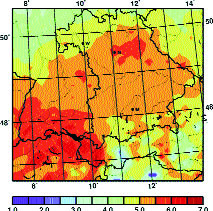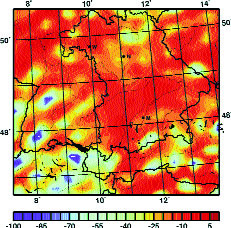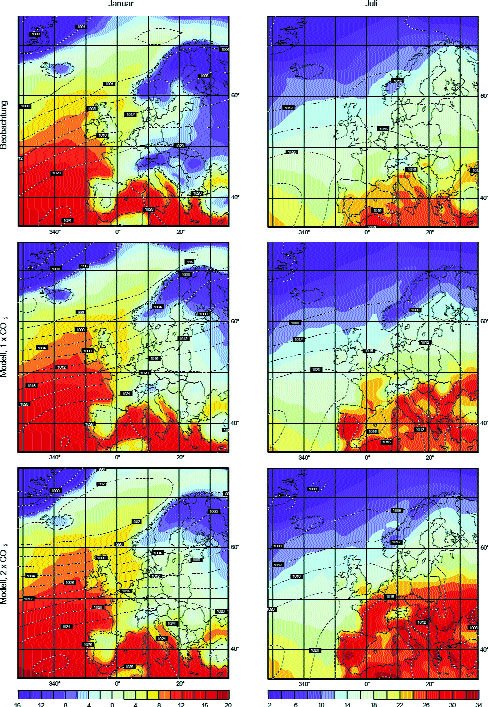According to the most recent state of knowledge, a doubling of the CO2 content of the atmosphere is not expected until between 2050 and 2070, but this increase in the greenhouse effect’s lead gas will undoubtedly lead to a worldwide rise in temperature.
Global climate models predict for Central Europe increases in air temperature of up to 2 K in winter and 3 K in summer, depending on the region, as well as a decrease in precipitation in summer and an increase in winter. In its final report of November 1999, the Bavarian Climate Research Association BayFORKLIM draws a detailed picture of these changes and shows that regional climate models – embedded in the results of global climate simulations (Fig. 1) of the Max Planck Institute for Meteorology – sometimes deliver even more extreme changes.
Warm areas can become even warmer
Since the climate cannot change in the same way regionally, but rather in a surprisingly differentiated way, a temperature increase of up to 6 K must be expected in summer in regions where the air temperature is already relatively high, such as in the Lake Constance area (Fig. 2). Since it is expected that the some- meral rainfall will also decrease over a large area (Fig. 3), the irrigation technology of golf courses will have to face difficult times. Water storage and recycling of service water will help to overcome the problems, but in the future we should learn to handle water more effectively and to strive for a higher efficiency. Such measures begin, for example, with the installation of sprinklers with individual control and controlled sectors or perma- nemagnetic water post-treatment, which causes a more homogeneous moistening of the soil and multiplies the efficiency of the irrigation process.
Dry areas can become even drier
With the increased temperature values, evaporation increases at all altitudes and thus also leads to a reduction in soil moisture. With a simultaneous increase in the number and duration of dry periods in summer, this development means that in the future not only the greens, tees and fairways will have to be considered when it comes to irrigation problems, but also the entire surroundings of the game. The quality of the course is not only determined by the condition of the playing areas, but the surroundings are also significantly involved. Stress symptoms can already be registered on the trees under changed environmental conditions, indicating that one or the other of the solitary trees will never become a tree. In the future, suitable choice of variety, artificial irrigation or drainage will also have to be taken into account in the planning area outside the golf courses when it comes to questions of quality assurance in golf.
Wet areas can get even wetter
While summer precipitation levels will decrease, winters will become wetter; the frequency of floods will also increase in winter, as will the flood peaks that occur in small catchment areas during heavy rainfall. In the future one will have to learn to pay attention to the criteria of climate change when looking for suitable golf courses in order not to drown in the truest sense of the word.
Windy areas can become stormy

Greenhouse effect also means more kinetic energy, as the experience of recent years shows with an increasing tendency towards more wind and storms. For the golfer this means more difficult playing conditions and more stress for the greenkeeper. Fairways that are exposed to constant wind tend to dry out and need more intensive treatment. Wind protection measures in the form of planting so-called wind protection belts can help. However, this requires not only sufficient planting area along the fairways but also considerable financial resources. When planning new golf courses, the climatic changes with regard to wind loads must therefore also be taken into account when selecting the terrain.
Climate models gain in importance
Although climate simulations are not predictions in the strict sense – influencing factors such as future greenhouse gas emissions, the consumption of fossil fuels, economic growth or large-scale interventions in current land use are too uncertain – they do indicate the direction in which our climate will develop under certain conditions. The golf scene must also take note of the statements of such models and react to them in good time. Statements such as “there is enough rain in the foothills of the Alps” can no longer be heard and no responsible operator can do without irrigation systems for fairways. In the future, it will pay more attention to local climate data and – as far as available – take into account forecasts of climate change.
Summary: Water is becoming increasingly valuable

It is undisputed that global climate change will also have a strong influence on the regional-climatic conditions for the Gulf in the coming decades. However, experience shows that there is always a need for action only when the first damage is already visible. It is certainly easier to convince players of the danger of increased UVB exposure – also a product of global climate change – and to “protect” themselves than to receive subsidies from them for tomorrow’s problems. But if the number of so-called “hot days” (max. air temperature above 30 °C, Fig. 4) actually doubles in the region, the irrigation systems literally run out of water due to the predicted reduction in precipitation and the golf course dies of thirst, then the search for culprits begins. Already today we should think of rainwater retention basins in the form of larger ponds and lakes, recover rainwater from sprinklers and supply it to a water treatment plant; above all, however, the water loss – which is more than 30 % according to experience – should be reduced by physical water treatment. No new technologies would have to be developed for this purpose, they are already successfully in use.
PS. Further information on regional climate changes can be found on the Bayer website. BayFORKLIM climate research association at , whom we would also like to thank for providing the illustrations (Source: “Climate change in Bavaria and its effects”, BayFORKLIM, final report, Munich, Nov. 1999).






